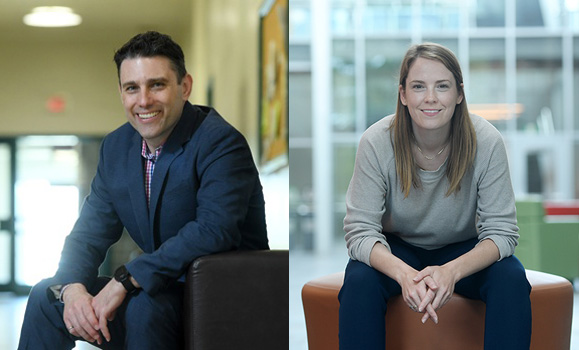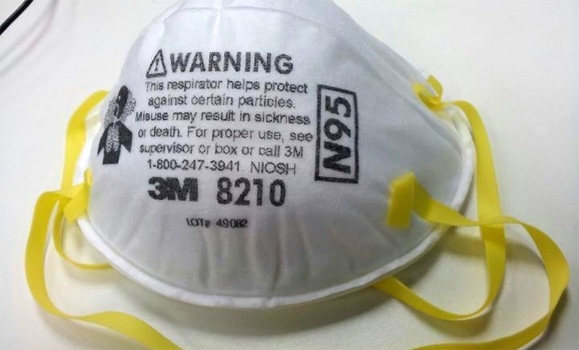The COVID-19 pandemic has created a massive demand for Personal Protective Equipment (PPE), especially N95 masks, which are designed to filter out at least 95% of very small particles, including droplets from viruses.
The masks, typically, are not designed for re-use, which is why the Centers for Disease Control and Prevention (CDC) and the National Institute for Occupational Safety and Health (NIOSH) do not recommend decontamination of these masks for reuse as standard care. However, if there are shortages in times of crisis, this is something that can become necessary.
Researchers at AVæ„¿÷≤ø and Nova Scotia Health have been looking at how the same UV light treatment used to disinfect water and wastewater can be applied to a different space and help with the decontamination process of this critically important piece of PPE.
“It all started with a call from Margaret Palmeter (director of the ) who was working with Nova Scotia Health to address COVID-19 issues that they had identified,” says Graham Gagnon, director of the Centre for Water Resources Studies and associate vice-president research at Dal. “So, we thought about our research knowledge in water disinfection and realized that UV technology could be a great fit.”

Researchers Graham Gagnon (left) and Amina Stoddart.
And with that realization, Dr. Gagnon, along with Amina Stoddart, Chris Smith, Craig McCormick, Carolina Ontiveros and a team of researchers quickly got to work modifying a commercially available UV disinfection system typically used for hospital rooms, and turned it into a UV-inactivation system to decontaminate N95 masks.
Safe and effective decontamination
The use of UV light for disinfection purposes has many advantages, including the fact that it is touchless, can be administered without altering a room’s ventilation, does not leave behind any residue, and provides a broad spectrum of action with rapid disinfection cycles.
For this study, the researchers used a commercially available UV disinfection system, which was previously acquired by Nova Scotia Health and used for disinfecting hospital rooms and enclosures. The MoonBeam3 BY Diversey∞’≤—Ã˝ has three adjustable, articulating arms that can be positioned at almost any angle to direct UV light.¬Ý The system is controlled by a central tower that was placed outside of the area of disinfection, and the lamps on the unit are programmable by a control panel located on the light tower. It is able to emit light for 90-, 180-, 300- and 600-second disinfection cycles.
These masks may become contaminated by a variety of pathogens from not only infected patients, but also from the individual wearing the mask, so a sterilization technique that was effective for a wide range of infectious agents was required. The masks (also provided by Nova Scotia Health) were cut into pieces, and inoculated with Escherichia coli (E. coli); Staphylococcus aureus (causes a range of illnesses from skin infections to pneumonia and meningitis); Geobacillus stearothermophilus spores (often used to validate sterilization); Bacillus cereus (can cause foodborne illness); Pseudomonas aeruginosa (can cause¬Ý generalized¬Ýinflammation¬Ýand¬Ýsepsis); and influenza A virus.
‚ÄúIn the water treatment world E. coli and T1 virus are often common organisms and were selected by our team,‚Äù says Dr. Gagnon.¬Ý‚ÄúHowever the clinical researchers on our team, Dr. Ross Davidson, and Dr. Ian Davis, suggested that Staph and influenza are more relevant from a public health standpoint.‚Äù
The initial results from the study are promising. There was no E. coli growth in any of the UV treated samples, it was effective in inactivating the influenza A virus each time, and the results indicate that UV light is a suitable and touchless treatment option for health-care professionals using N95 masks and their strategy against the spread of COVID-19. The next steps for the researchers involved include airflow testing, fit testing of the masks, and the number of viable disinfection cycles.
‚ÄúWe are now working with Dr. Rachael Chang and Dr. Jong Sung Kim to address airflow and fit testing following disinfection,‚Äù says Dr. Gagnon.¬Ý‚ÄúSo far the results look very good and we suspect that UV technology will remain as an effective disinfection technology for N95 masks.‚Äù
Responding to the current needs of Nova Scotians
The project received funding from the Nova Scotia Health Research Coalition, a collaborative partnership between Nova Scotia Health Research & Innovation (Nova Scotia Health),¬ÝAVæ„¿÷≤ø,¬ÝAVæ„¿÷≤ø Medical Research Foundation, the¬ÝQEII Health Sciences Centre Foundation, the¬ÝIWK Foundation, the¬ÝIWK Health Centre, the¬ÝDartmouth General Hospital Foundation (DGHF)¬Ýand¬ÝResearch Nova Scotia (RNS).
The coalition is dedicated to fostering a research environment that engages academic partnerships and responds to the current needs of Nova Scotians and the provincial health-care system, in addition to maintaining expertise in innovative research, discovery science, population/social sciences and health system improvement. On May 4, 2020, the partners announced an investment of just over $1.5 million in 40 COVID-19 research teams.
The team also received funding from the and .
More information about this study can be found in the paper, , which was published in the journal Environmental Science: Water Research and Technology.

